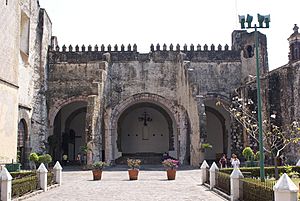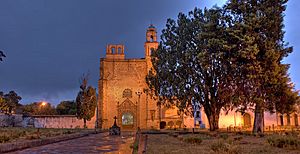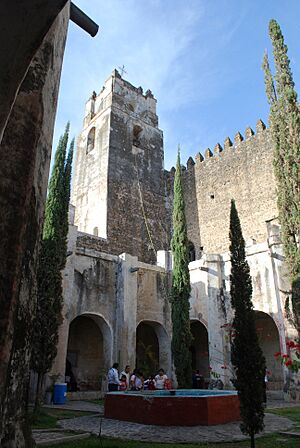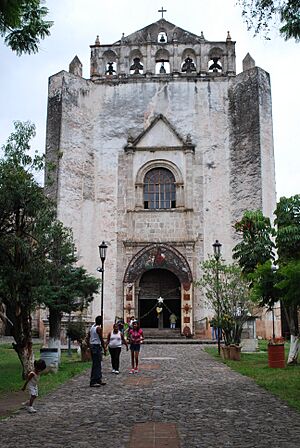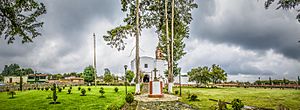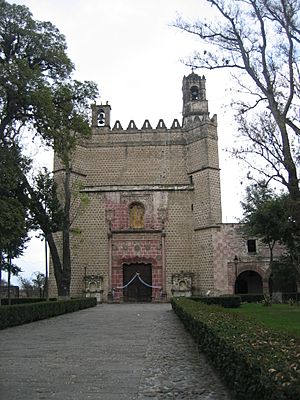Monasteries on the slopes of Popocatépetl facts for kids
Quick facts for kids Earliest monasteries on the slopes of Popocatépetl |
|
|---|---|
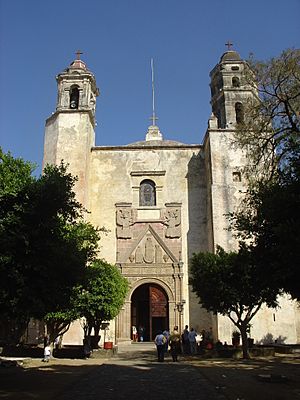
View of the church façade of the monastery in Tepoztlán
|
|
| Location | Areas south and east of Popocatépetl, Mexico |
| Built | 16th Century |
| Built for | The Augustinians, the Franciscans and the Dominicans |
| Type | Cultural |
| Criteria | ii, iv |
| Designated | 1994 (18th session) |
| Reference no. | 702 |
| Region | Latin America and the Caribbean |
The Earliest Monasteries on the Slopes of Popocatépetl are a group of sixteen old monasteries from the 1500s. They were built by three religious groups: the Augustinians, the Franciscans, and the Dominicans. Their goal was to teach Christianity to people living south and east of the Popocatépetl volcano in central Mexico.
In 1994, UNESCO named these monasteries World Heritage Sites. This is because they were a great example for how early monasteries and churches were built. They also showed how Christian teachings spread in New Spain (which is now Mexico) and other parts of Latin America. These monasteries often have a very large open courtyard called an atrium in front of a church. The church usually has one main room and an open chapel. The atrium was a special meeting place where missionaries and local people could gather. Church services for new converts were often held outdoors in the atrium. This design was copied in many other places as the missionaries traveled across New Spain.
Today, all sixteen monasteries are open for visitors. Eleven are in northern Morelos, three are in the state of Puebla, and one is in Tlaxcala. The twelve in Morelos are even part of a special "Route of the Volcano" or "Route of the Monasteries" for tourists. In 2021, the Cathedral of Tlaxcala was added to this important heritage site.
Contents
Where Are These Monasteries?
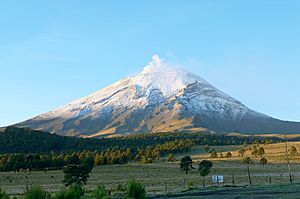
The World Heritage Site includes sixteen monasteries located south and east of Mexico City. Most of them are in the state of Morelos. Three are in the state of Puebla, and one is in Tlaxcala.
The monasteries in Morelos are found in towns like Atlatlahucan, Cuernavaca, Tetela del Volcán, Yautepec, Ocuituco, Tepoztlán, Tlayacapan, Totolapan, Yecapixtla, and Zacualpan de Amilpas. The three in Puebla are in Calpan, Huejotzingo, and Tochimilco. Many of these monasteries are built on the lower slopes of the Popocatépetl volcano.
Even though Popocatépetl is an active volcano, the monasteries have not been harmed by its activity. Some have been damaged by earthquakes, though. The risk from the volcano is low for these monasteries and other historical buildings nearby. This is because lava flows in this area are usually slow, and the buildings were not constructed in places where lava often runs.
Why Are They World Heritage Sites?
The UNESCO World Heritage Site includes sixteen monasteries. Most are in Morelos, three in Puebla, and one in Tlaxcala. They were named a World Heritage Site on December 17, 1994. This was because they set the example for how monasteries were built and how Christianity was spread across the Americas.
These buildings show how the first Franciscan, Dominican, and Augustinian missionaries used a special architectural style. This style included using large open outdoor spaces. This idea of open spaces in church and monastery designs was then used throughout Mexico and other parts of Latin America.
There is some debate about whether the monasteries were completely European in design. Some think they also used ideas from local native ceremonial spaces. However, the use of open chapels and "capillas posas" (small chapels in the corners of the atrium) in large courtyards helped new native converts. These people were not used to going inside big enclosed buildings. The atrium became a very important meeting place for the missionaries and the local people.
These sixteen monasteries were built right at the start of the Christian teaching period, after the Spanish conquered the Aztec Empire.
After these sites became World Heritage Sites, the Instituto Nacional de Antropología e Historia (INAH) promised millions of pesos to fix and protect eleven of the monasteries. Much of the money was used to fix problems caused by dampness in the walls. One of the first projects was to restore the wall paintings in the Tetela del Volcán monastery. Another early project was to fix the gardens and fields of the Atlatlahucan monastery. These fields now grow avocados and other crops. Selling these crops helps pay for the monasteries' upkeep.
More than 70% of the monasteries built in the 1500s are still in good condition. However, some people say that not enough money is given for their restoration. They say it's much less than what is spent on other famous places like the Basilica of Guadalupe. Much of the work done has been to restore the atrium areas, the paths used for processions, and the atrium chapels. Another big effort is to remove moss and plants growing on the buildings. Restoration work has also led to finding old wall paintings again. But much more restoration is still needed.
To help more people learn about the World Heritage monasteries in Morelos, the state promotes them as the "Route of the Monasteries" or "Route of the Volcano." This route starts in Cuernavaca, where the monastery church is now the city's cathedral. The route then goes east and north through Tepoztlán, Oaxtepec, Tlayacapan, Totolapan, Atlatlahuacan, Yecapixtla, Ocuituco, Tetela del Volcán, and Hueyapan. It ends in Zacualpan de Amilpas.
Monasteries List
The sixteen 16th-century monasteries recognized by UNESCO as World Heritage Sites are located around the foothills of the Popocatépetl Volcano. Here is a list of them:
| Code | Image | Name | Town | State | Coordinates | Protected area |
|---|---|---|---|---|---|---|
| 702-001 | 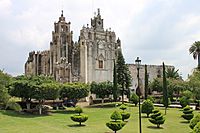 |
Convent of San Mateo Apóstol y Evangelista | Atlatlahucan | Morelos | 18°56′5″N 98°53′52″W / 18.93472°N 98.89778°W | Property: 1.23 ha. Buffer zone: 0.13 ha. |
| 702-002 | 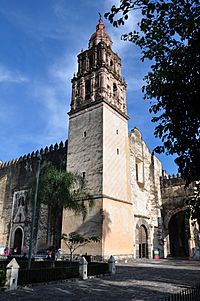 |
Cuernavaca Cathedral | Cuernavaca | Morelos | 18°52′2″N 99°14′42″W / 18.86722°N 99.24500°W | Property: 1.57 ha. Buffer zone: 1.43 ha. |
| 702-003 | 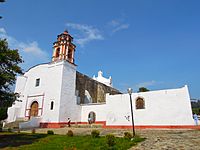 |
Convent of Santo Domingo de Guzmán, Hueyapan | Hueyapan | Morelos | 18°53′10″N 98°41′25″W / 18.88611°N 98.69028°W | Property: 0.91 ha. Buffer zone: 0.5 ha. |
| 702-004 | 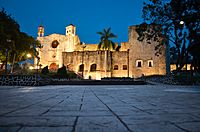 |
Convent of Santo Domingo de Guzmán, Oaxtepec | Oaxtepec | Morelos | 18°54′25″N 98°58′15″W / 18.90694°N 98.97083°W | Property: 0.99 ha. Buffer zone: 1.14 ha. |
| 702-005 | 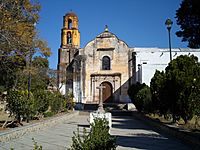 |
Augustinian Convent and Church of Santiago Apóstol | Ocuituco | Morelos | 18°52′37″N 98°46′32″W / 18.87694°N 98.77556°W | Property: 0.62 ha. Buffer zone: 1.28 ha. |
| 702-006 | 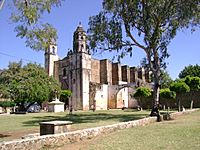 |
Convent of la Natividad or de la Anunciación | Tepoztlán | Morelos | 18°59′10″N 99°5′7″W / 18.98611°N 99.08528°W | Property: 1.42 ha. Buffer zone: 1.31 ha. |
| 702-007 | 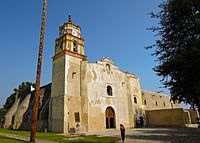 |
Convent of San Juan Bautista | Tetela del Volcán | Morelos | 18°53′31″N 98°43′46″W / 18.89194°N 98.72944°W | Property: 1.19 ha. Buffer zone: 2.89 ha. |
| 702-008 | 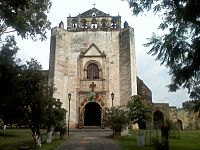 |
Convent of San Juan Bautista | Tlayacapan | Morelos | 18°57′20″N 98°58′52″W / 18.95556°N 98.98111°W | Property: 0.62 ha. Buffer zone: 1.36 ha. |
| 702-009 | 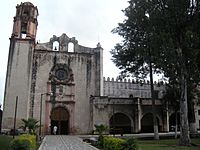 |
Convent of San Guillermo | Totolapan | Morelos | 18°59′24″N 98°55′6″W / 18.99000°N 98.91833°W | Property: 3.61 ha. Buffer zone: 1.23 ha. |
| 702-010 | 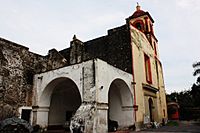 |
Dominican Convent and Church la Asunción de María | Yautepec | Morelos | ||
| 702-011 | 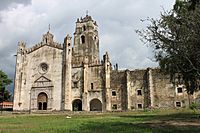 |
Convent of San Juan Bautista | Yecapixtla | Morelos | 18°53′3″N 98°51′47″W / 18.88417°N 98.86306°W | Property: 1.2 ha. Buffer zone: 3.13 ha. |
| 702-012 | 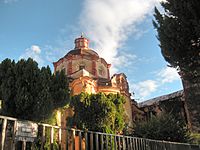 |
Convent of la Inmaculada Concepción | Zacualpan de Amilpas | Morelos | 18°47′11″N 98°46′5″W / 18.78639°N 98.76806°W | Property: 1.94 ha. Buffer zone: 0.24 ha. |
| 702-013 | 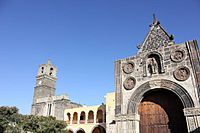 |
Convent of San Francisco de Asís | Calpan | Puebla | 19°6′0″N 98°27′54″W / 19.10000°N 98.46500°W | Property: 1.51 ha. Buffer zone: 0.75 ha. |
| 702-014 | 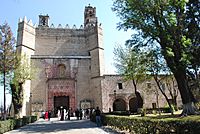 |
Convent of San Miguel Arcángel | Huejotzingo | Puebla | 19°9′27″N 98°24′13″W / 19.15750°N 98.40361°W | Property: 5.65 ha. Buffer zone: 1.29 ha. |
| 702-015 | 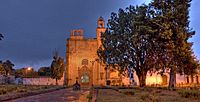 |
Convent of la Asunción de Nuestra Señora | Tochimilco | Puebla | 18°53′28″N 98°34′21″W / 18.89111°N 98.57250°W | Property: 1.1 ha. Buffer zone: 2.4 ha. |
| 702-016 |  |
Franciscan Ensemble of the Monastery and Cathedral of Our Lady of the Assumption of Tlaxcala | Tlaxcala de Xicohténcatl | Tlaxcala | 19°18′50.34″N 98°14′15.57″W / 19.3139833°N 98.2376583°W | Property: 2.82 ha. |
These monasteries are World Heritage Sites because their design became a model for later monasteries and towns. They were built very strongly with thick walls and looked quite plain. Some even have stone decorations that make them look like castles or forts. These were for defense, as the monks were entering new lands to introduce a new religion. Because of this, these types of churches and monasteries are sometimes called "fortress temples."
Most monasteries have a large open courtyard (atrium) in front of the church. They also feature an open chapel, four small chapels in each corner of the atrium, and a stone cross in the middle. The walls of the atrium often have markings for the Stations of the Cross. The main church is covered by a roof, and there is a separate area for the monks called the cloister.
Unlike churches built later, the atrium was very important in these early monasteries. They were first built to help spread Christianity. Each monastery had only a few monks but hundreds of new converts. The atrium and its open chapel were built first to hold large groups of people. This also helped because many native ceremonies were held outdoors. The atriums are surrounded by low walls, usually less than five meters high, to make the space feel more welcoming while still being outside.
The open chapels were almost always built next to the main church, facing the atrium. Since most native people could not read or write, the churches and open chapels were painted with Bible stories. This helped teach people through pictures. The four corner chapels in the atrium are called capillas posas. They were used during religious parades, especially during Corpus Christi, to hold the sacred bread.
In the center of the atrium, a large stone cross was placed. On the outside of these early churches, crosses almost always appear without the figure of Christ. This was done so that the friars did not want the native people to connect their old practice of human sacrifice with the new religion.
The large churches usually have only one main room. On one side, often the south, is the cloister area where the monks lived. Most cloisters have or had wall paintings, large gardens, and fountains. The decorations often mix different European styles from that time. For example, some have rose windows like French cathedrals, doorways similar to those in Spain, and even Islamic-style triangular altars. Some hidden elements, like certain numbers important to native beliefs, can be found in the churches. It is not known if the friars allowed these or if they were added secretly.
History of the Monasteries
These monasteries are a key part of the early history of Christianity in Mexico. The Franciscans were the first to be invited by Hernán Cortés. Soon after, the Dominicans and Augustinians also arrived. After settling in Mexico City and the Valley of Mexico, they began teaching Christianity in the area south and east of the volcano.
Important missionaries included Juan de Tecto, Juan de Ayora, and Pedro de Gante. Pedro de Gante even learned Nahuatl, the language of the local people, to communicate better. The first monasteries were built by the Franciscans in 1524. These included Huejotzingo, Cuernavaca, Calpan, and Tochimilco. The Dominicans followed in 1526, building Oaxtepec, Tepoztlan, Tetela del Volcán, and Hueyapan. The Augustinians arrived in 1533 and founded monasteries in Ocuituco, Totolapan, Yecapixtla, Tlayacapan, Atlatlahuacan, and Zacualpan de Amilpas. Later, these same monasteries sent missionaries to other parts of New Spain, like Guerrero, Oaxaca, Chiapas, and Guatemala.
The monasteries became the main centers for the towns that the Spanish founded or reorganized in the early colonial period. The local people were settled around these monasteries. The monasteries also served as early hospitals, schools, and places to store food and water. Aqueducts often brought water directly to them. The Augustinians not only taught Christianity but also set up the first schools for native people to learn European subjects. The Dominicans focused more on helping the local economy grow, using the fertile land. They were more active in higher altitude areas.
Some monasteries, like the one in Tlayacapan, were used as army camps during the Mexican Revolution. Soldiers' drawings from that time have been found there. Others, like Yecapixtla, also have recent drawings due to a lack of security.
Individual Monasteries: Highlights
The monastery of La Asunción in Cuernavaca is now known as the city's Cathedral. It was founded by the Franciscans. At first, only Spanish people and native nobles were allowed inside. It was the fifth building in New Spain ordered by Toribio de Benavente Motolinia. This cathedral is the only one of the original fourteen monasteries that has changed a lot over time. Because Cuernavaca was an important city, the church and its grounds were changed several times. The large open chapel was turned into a doorway, and the atrium chapels were made bigger, becoming significant churches themselves. Major renovations happened in the late 1970s and early 1980s. These included restoring its wall paintings and adding modern parts, especially to the main altar. The cloister still has many frescos, some showing missionaries from New Spain in the Philippines and Japan. The open chapel is often used for weddings.
The monastery of La Natividad de Nuestra Señora in Tepoztlán is on a hill in the Tepozteco Valley. It was built between 1550 and 1564 and still stands tall over the town. It started with only five Dominican friars. The large atrium has a big stone cross with symbols of the Passion. There is an open chapel and corner chapels, but most of these are now in ruins. The cloister has decorative bands with the coat of arms of the Dominican order. You can see a mix of native and Catholic beliefs here. For example, there is an angel with European features but with eagle's wings, like those found on Quetzalcoatl. Inside, there is a wall painting of a xoloitzcuintle dog with a torch in its mouth. The walls also have a border of squash flowers and roses, surrounded by precious stones, including a native one called "chalchihuite." The plaza in front of the monastery in Tepoztlán is often busy with a market called a tianguis. This market sells everything from food to items for New Age practices.
The monastery of Tlayacapan was built by the Augustinians between 1554 and 1572. It has one of the largest churches in Morelos state. Its style is mostly Renaissance, but it also has Gothic features. Here too, you can find a mix of cultures, with suns and moons in the church's decorations. The open chapel and cloister area have been turned into a museum run by a local group. This museum has the best-preserved black-and-white wall paintings from the complex. It also displays old native and colonial items, as well as some mummified remains from the 1700s. The preserved wall paintings cover over 2,700 square meters and show figures and scenes like the Dream of Saint Joseph, Catherine of Siena, and the Presentation of Christ at the Temple.
The monastery of San Guillermo Abad is in Totolapán and was built by the Augustinians in 1553. Its cloister is small, even though its walls are very thick. The corner chapels in the atrium are still complete. The church has several notable oil paintings and an old organ in the choir. There is also a striking two-color decorative band in one of the rooms on the first floor of the cloister, near the main front of the church. This and other wall paintings in the inner hallways of the cloister have been recently restored. Stone arches and pillars are decorated with small stones set in cement.
The Dominican monastery of Santo Domingo in Oaxtepec is on a steep hill above an ancient native ceremonial platform. Because of this, the atrium is not directly in front of the church and is higher than the church. Inside the church, Gothic arches support the roof, and the ceiling is decorated with flower designs. There are two wooden altarpieces from the 1600s. The monastery of Oaxtepec has pillars in the cloister with images of saints. Its arched ceilings are decorated with repeating designs like the fleur-de-lis. Some wall paintings here still have traces of blue color, which is unusual, but most have lost their color completely. Many wall paintings have disappeared due to dampness, mostly because the roof's drainage was not maintained. The monastery's cloister has been turned into a museum, but only three of its rooms are open to the public. It has a small collection of ancient native items and local animals, insects, and plants.
The monastery of San Mateo Apostol in Atlatlahuacán was built by the Augustinians around 1570. It stands on the remains of an ancient native temple, on the highest part of the town. The Stations of the Cross in the atrium are shown by small chapels on the outside of the atrium wall. It has two covered chapels in its atrium. One of these has a wall painting of the family tree of Saint Augustine. The front of the church is very tall, which is common in Augustinian buildings, reaching about 50 meters high. Wall paintings covered most of the inside of the complex. The arched ceilings mix Moorish styles with those of the Italian Renaissance. Confession booths were built in an "s" shape in the wall between the church and the cloister. In the cloister, a main attraction is a ceiling vault on the ground floor. It is decorated with a chain made of images of the Sacred Heart of Jesus. The upper level is now the home of the local priest.
The monastery of Santiago Apostol in Ocuituco dates from 1534. It was the first Augustinian monastery on the American mainland. Fray Juan de Zumárraga held its first mass in 1534. It was a center for teaching Christianity and also for training monks. The monastery has an arched ceiling on the lower floor of the cloister with figures in browns, whites, and greens. The chapel for pilgrims is closed, unlike in other monasteries, but the rest of the complex is open to visitors. The buildings have been changed a bit since they were built. However, one well-preserved part is its 16th-century stone fountain, which is the oldest of all the World Heritage Site monasteries. This fountain is a copy of one found in the Alhambra in Córdoba, Spain. It has six sandstone lions facing the center, carved by native craftsmen. Outside the cloister, there is another fountain, once known as the Fountain of the Mermaids, but it is now badly damaged. Both fountains provided water to the community, flowing from Popocatépetl.
The monastery of Santo Domingo de Guzmán in Hueyapan is the highest of the monasteries in Morelos state. Its climate is cold compared to most of the state. It is one of the monasteries closest to the volcano. It was founded by the Dominicans, but its cloister was built of adobe and wood with a tile roof instead of stone. It fell apart relatively quickly due to the weather and was abandoned. It remains mostly closed today. Only the atrium area is open to visitors, and it closes by 1 PM each day. The simple front of the main church still stands and has a notable Baroque-style alcove. You can also see some of its remaining wall paintings.
The monastery of San Juan Bautista in Tetela del Volcán was built by the Dominicans in the first half of the 1500s. Even Hernán Cortés visited it. It is at a high altitude near the volcano, surrounded by pine forest, in a relatively cold climate. The outside has arches that surround the complex, but they are partly hidden by trees. The upper parts of the walls around the complex are covered in paint. The lower floor of the cloister has figures painted in the arches and walls. Many are of Augustinian monks. In the arched ceilings over the walkways, there are many cherubs fighting evil spirits, and some are even fighting each other. A unique architectural feature is the Moorish-style wooden-beam roof in the sacristy. A crafts market is held here every Wednesday. The atrium has a series of very high-quality wall paintings, done by a local native artist in the 1500s. They were restored in 2008.
The Augustinian monastery of San Juan Bautista in Yecapixtla was designed by Jorge de Ávila and Jeronimo de San Esteban. Their plans were based on the Metropolitan Cathedral in Mexico City. The atrium wall has 365 triangular sculptures, similar to those found in ancient native temples called teocallis, as well as castle-like decorations. The atrium area still has its corner chapels and its central stone cross. The front of the church is considered one of the best examples of Renaissance architecture in New Spain. However, it also has a Gothic-style rose window. The cloister is large and well-lit. It has only one floor in the back, but usually cloisters have two floors all around. The front of the cloister does have two floors. In the entrance for pilgrims, there is an image of the Virgin Mary surrounded by cherubs. This image has a blue background, a color rarely used in church and monastery decorations of that time. The arched ceiling on the lower floor of the cloister is at least 10 meters high and has remnants of wall paintings, such as Stations of the Cross and scenes from the daily life of Augustinian friars. It also contains a fountain from the 1600s.
The monastery of La Concepción in Zacualpán was built by the Augustinians. It has kept much of its original design, including the layout of the gardens and homes around it. Water here comes from the melting snows of Popocatépetl. The baptistery has an arch, and its wall has remains of a painted altar. Its Rosario Chapel has other small, high-quality Baroque altars. There is a stone baptismal font made by native hands and a series of chapels in the atrium from the 1700s. There are also several artworks from the same time period.
Huejotzingo is the oldest of the fifteen monasteries, built in 1524. It is also one of the most impressive because many of its original parts are well-preserved. The atrium has four corner chapels that are some of the most detailed of their kind from colonial Mexico. They are beautifully carved from sandstone. The main altar is from the 1500s, and only three others in Mexico are as old. The atrium cross has a detailed crown of thorns. The remains of the old water system (aqueduct) can be found on one of the atrium walls.
Calpan was taken over by Cortés himself in 1522. The Franciscans arrived here to build the San Andrés Apostol monastery complex in 1548 under Juan de Alameda. The corner chapels were started in 1555. The front of the church is in the Plateresque style, with some Moorish influence. It is decorated with Isabelina volutes (spiral shapes) on the entrance arch, with shells on top. There is one bell tower on the right side. Its single main room is wide, with a choir area that was initially just for the friars so they would not be seen by the general public. The cloister is now a museum, and you enter it through the open chapel.
The chapels, made of pink sandstone in the corners of the atrium, are famous for their finely carved designs. The first chapel is next to the cloister and is dedicated to the Virgin Mary. It has wall paintings with raised designs about Mary's life and suffering. The second is to the left of the first and is dedicated to Saint Francis of Assisi, with similar pictures about him. The third is dedicated to the Archangel Michael, and the last to John the Baptist, following the same pattern. These unique chapels are why this monastery was included in the World Heritage Site.
The Asunción de Nuestra Señora monastery in Tochimilco gets water from the volcano through a long aqueduct. This brings water directly into the building and to a 16th-century fountain in the town's plaza. The inner walls of the atrium have special spots for each of the Stations of the Cross. This monastery was damaged by an earthquake in 1999, which harmed its walls and arched ceilings. However, this damage was repaired during restoration work between 2001 and 2003. The monastery also hosts temporary exhibits, such as one on old maps of Tochimilco, sponsored by the INAH. This exhibit featured maps borrowed from the Archivo de Indias in Seville, Spain.
See also
 In Spanish: Monasterios en las faldas del Popocatépetl para niños
In Spanish: Monasterios en las faldas del Popocatépetl para niños


